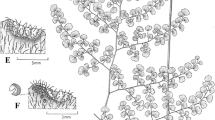Abstract
The leaf micromorphology of Antarctic pearlwort, Colobanthus quitensis (Kunth) Bartl. was analyzed. Plants were collected at King George Island (62°5′S, 58°23′W). Leaves were analyzed by optical and scanning electron microscopy, and quantitative analyses performed on leaf tissues and their internal geometry. C. quitensis leaves are ca. 588 μm thick, and composed of palisade and spongy parenchyma, respectively ca. 171 and 312 μm thick. Cuticles are thin and cover short epidermal cells. The central vein is surrounded by two bundles of achlorophyllous cells. Sclerenchymatic tissues are poorly developed. SEM analysis reveals faint striations over leaf surfaces. Stomata are present on both surfaces, but restricted to the leaf margins on the abaxial side. The ratio of mesophyll cell surface area per unit leaf area (Ames/A) is 34.2. The number of cells per cross-sectional area occupied was 24% higher for the palisade than for the spongy tissue, which determines a higher cell surface area per cross-sectional area for the former tissue. The authors correlate these results to plant ecological distribution in Antarctica and to water and carbon economy.
Similar content being viewed by others
Author information
Authors and Affiliations
Additional information
Accepted: 14 January 2000
Rights and permissions
About this article
Cite this article
Mantovani, A., Cardoso Vieira, R. Leaf micromorphology of Antarctic pearlwort Colobanthus quitensis (Kunth) Bartl.. Polar Biol 23, 531–538 (2000). https://doi.org/10.1007/s003000000117
Issue Date:
DOI: https://doi.org/10.1007/s003000000117




